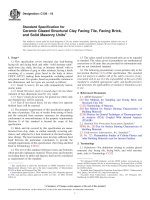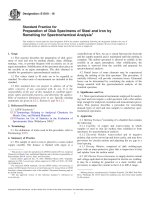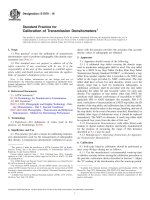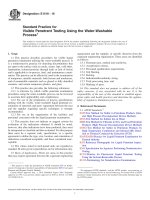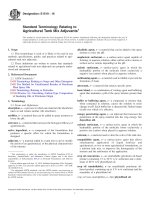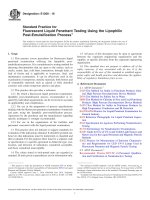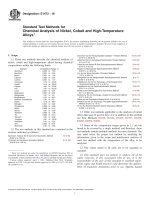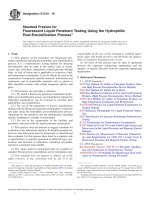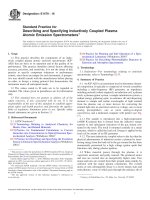Astm g 126 16
Bạn đang xem bản rút gọn của tài liệu. Xem và tải ngay bản đầy đủ của tài liệu tại đây (125.04 KB, 5 trang )
This international standard was developed in accordance with internationally recognized principles on standardization established in the Decision on Principles for the
Development of International Standards, Guides and Recommendations issued by the World Trade Organization Technical Barriers to Trade (TBT) Committee.
Designation: G126 − 16
Standard Terminology Relating to the
Compatibility and Sensitivity of Materials in Oxygen
Enriched Atmospheres1
This standard is issued under the fixed designation G126; the number immediately following the designation indicates the year of
original adoption or, in the case of revision, the year of last revision. A number in parentheses indicates the year of last reapproval. A
superscript epsilon (´) indicates an editorial change since the last revision or reapproval.
G94 Guide for Evaluating Metals for Oxygen Service
G114 Practices for Evaluating the Age Resistance of Polymeric Materials Used in Oxygen Service
G120 Practice for Determination of Soluble Residual Contamination by Soxhlet Extraction
G121 Practice for Preparation of Contaminated Test Coupons for the Evaluation of Cleaning Agents
G122 Test Method for Evaluating the Effectiveness of
Cleaning Agents
G124 Test Method for Determining the Combustion Behavior of Metallic Materials in Oxygen-Enriched Atmospheres
G125 Test Method for Measuring Liquid and Solid Material
Fire Limits in Gaseous Oxidants
G128 Guide for Control of Hazards and Risks in Oxygen
Enriched Systems
G131 Practice for Cleaning of Materials and Components by
Ultrasonic Techniques
G136 Practice for Determination of Soluble Residual Contaminants in Materials by Ultrasonic Extraction
G144 Test Method for Determination of Residual Contamination of Materials and Components by Total Carbon
Analysis Using a High Temperature Combustion Analyzer
G145 Guide for Studying Fire Incidents in Oxygen Systems
1. Scope
1.1 This terminology defines terms related to the compatibility and sensitivity of materials in oxygen enriched atmospheres. It includes those standards under the jurisdiction of
ASTM Committee G04.
1.2 The terminology concentrates on terms commonly encountered in and specific to practices and methods used to
evaluate the compatibility and sensitivity of materials in
oxygen. This evaluation is usually performed in a laboratory
environment, and this terminology does not attempt to include
laboratory terms.
2. Referenced Documents
2.1 ASTM Standards:2
D2863 Test Method for Measuring the Minimum Oxygen
Concentration to Support Candle-Like Combustion of
Plastics (Oxygen Index)
G63 Guide for Evaluating Nonmetallic Materials for Oxygen Service
G72 Test Method for Autogenous Ignition Temperature of
Liquids and Solids in a High-Pressure Oxygen-Enriched
Environment
G74 Test Method for Ignition Sensitivity of Nonmetallic
Materials and Components by Gaseous Fluid Impact
G86 Test Method for Determining Ignition Sensitivity of
Materials to Mechanical Impact in Ambient Liquid Oxygen and Pressurized Liquid and Gaseous Oxygen Environments
G88 Guide for Designing Systems for Oxygen Service
G93 Practice for Cleaning Methods and Cleanliness Levels
for Material and Equipment Used in Oxygen-Enriched
Environments
3. Terminology
3.1 Definitions:
aging, n—the exposure of a material to stress, such stress of
which may include time, pressure, temperature, abrasion,
ionizing radiation, light, impact with gas or particles, tensile
or compressive force (either static or cyclic), or any other
feature that may be present individually or in combination.
G114
accelerated aging, n—a type of artificial aging whereby the
effect of prolonged exposure during service is stimulated by
aging at elevated temperature.
G114
1
This terminology is under the jurisdiction of ASTM Committee G04 on
Compatibility and Sensitivity of Materials in Oxygen Enriched Atmospheres and is
the direct responsibility of Subcommittee G04.02 on Recommended Practices.
Current edition approved Dec. 15, 2016. Published January 2017. Originally
approved in 1994. Last previous edition approved in 2008 as G126 – 00(2008).
DOI: 10.1520/G0126-16.
2
For referenced ASTM standards, visit the ASTM website, www.astm.org, or
contact ASTM Customer Service at For Annual Book of ASTM
Standards volume information, refer to the standard’s Document Summary page on
the ASTM website.
artificial aging, n—aging in which a stress variable is outside
the domain of exposure that a material might see in a
component for oxygen service or in which an alternative
mechanism is used to produce an effect that simulates the
results of natural aging.
Copyright © ASTM International, 100 Barr Harbor Drive, PO Box C700, West Conshohocken, PA 19428-2959. United States
1
G126 − 16
DISCUSSION—The degree of artificiality may vary on a large scale. An
example of mild artificiality is exposure of a material to a greater
pressure than it experiences in the use condition. An example of
extreme artificiality is the use of sandpaper to increase a material’s
surface roughness to simulate particle-impact abrasion that occurs in
the use condition. A high degree of artificiality affects the strength of
conclusion that can be drawn, because it may be difficult to relate the
results to the use condition. Artificial aging that accelerates natural
G114
aging but does not alter the resulting effect is preferred.
DISCUSSION—In practice, the control coupon is contaminated in the
same manner as the test coupons and is subjected to the identical
G120, G121, G131
cleaning procedure.
degas, v—the process of removing gases from a liquid. G131,
G136
direct incident cause, n—the mechanical or thermodynamic
event (such as breakage of a component or near-adiabatic
compression), the physicochemical property (such as heat of
combustion), the procedure (such as a valve opening rate), or
any departure(s) from the intended state of any of these
items, that leads directly to ignition, or fire, or both. G145
autoignition temperature (AIT), n—the lowest temperature
at which a material will spontaneously ignite in an oxygenenriched atmosphere under specific test conditions.
G63, G72, G94, G128
direct oxygen service, n—service in contact with oxygenenriched atmosphere during normal operations.
average regression rate (Regression Rate of the Melting
Interface [RRMI]), n—the average rate at which the melting
interface advances along the test sample length as melting of
G124
the test sample occurs.
DISCUSSION—Examples are oxygen compressor piston rings or control valve seats.
G63, G88, G94
energy threshold, n—the highest impact energy level at a
given pressure for which the passing criteria have been met.
G86
blank, n—the contamination level of a fluid when the test
coupon is omitted.
DISCUSSION—Sometimes referred to as the “background level.”
exemption pressure, n—the maximum pressure for an engineering alloy at which there are no oxygen velocity restricG94
tions (from CGA 4.4 and EIGA doc IGC13).
G121
burn length, n—the burn length is the length of the sample that
has been consumed by burning.
fibers, n—particulate matter with a length of 100 µm or greater
G93
and a length-to-width ratio of 10 to 1 or greater.
DISCUSSION—The burn length is determined by subtracting the
post-test sample length from the pretest sample length (which does not
include the promoter length or the region used by the test sample
G124
support).
fire limit, n—the threshold limit conditions that will just
support self-sustained burning of a material under a combination of specified conditions and at least one variable
parameter. (Typically oxidant concentration, diluent nature,
pressure, temperature, geometry, flow or flame parameters
G125
etc.)
characteristic elements, n—those factors that must be present
for an ignition mechanism to be active in an oxygenenriched atmosphere. The more characteristic elements present for a particular ignition mechanism, the more active that
G88
mechanism is.
flammable material, n—a material that is able to ignite and
demonstrate self-sustained burning per specific test method
criteria considering configurational, environmental, and promoter energy conditions (example: Oxidizer%, P, T, etc.).
cleaning effectiveness factor (CEF), n—the fraction of contaminant removed from an initially contaminated test couG122
pon as determined by gravimetric techniques.
DISCUSSION—It is noteworthy that a material’s flammability in
oxygen is highly-dependent on multiple factors (configuration,
environment, promoter energy, etc.) and caution is advised to consider
these factors when evaluating a material’s flammability in a given
G124
oxygen application.
cleanliness, n—the degree to which an oxygen system is free
of contaminant.
DISCUSSION—Cleanliness and contamination are opposing properties:
increasing cleanliness implies decreasing contamination.
G93
fractional evaporation, n—the continuous evaporation of the
quantity of liquid that results in a progressive concentration
G145
of a less-volatile constituent(s).
contaminant (contamination), n—unwanted molecular, nonvolatile residue (NVR), or particulate matter, or combinations thereof, that could adversely affect or degrade the
operation, life, or reliability of the systems or components
upon which it resides.
galling, n—a condition whereby excessive friction between
high spots results in localized welding with subsequent
splitting and a further roughening of rubbing surfaces of one
G88
or both of two mating parts.
DISCUSSION—Contamination and cleanliness are opposing properties:
increasing cleanliness implies decreasing contamination. G93, G120,
G121, G131, G136, G144, G145
gaseous fluid impact-igintion resistance, n—the resistance of
a material to ignition when struck by rapidly compressed
high pressure gas in an oxygen enriched atmosphere under a
G63
specific test procedure.
contaminate, v—a process of applying contaminant. (nonvolatile residue (NVR) and/or particulate matter). G131,
G136, G120, G121
control coupon (witness coupon) , n—a coupon made from the
same material and prepared in exactly the same way as the
test coupons which is used to verify the validity of the
method or part thereof.
hazard, n—source of danger; something that could harm
persons or property.
DISCUSSION—The magnitude of a hazard relates to the severity of the
harm it could cause.
G128
2
G126 − 16
highest no-burn pressure, n—the highest gas pressure tested
(at a specified oxygen concentration and fixed sample
temperature) at which a material does not burn more than
G124
specific test method criteria.
mechanical impact-ignition resistance, n—the resistance of a
material to ignition when struck by an object in an oxygenenriched atmosphere under a specific test procedure. G63,
G94, G128
highest no-burn temperature, n—the maximum sample temperature (at a specified oxygen concentration and pressure)
at which a material does not burn more than specific test
G124
method criteria.
molecular contaminant (non-particulate contamination),
n—molecular contaminants that may exist in a gaseous,
liquid, or solid state and may be uniformly or nonuniformly
disturbed.
DISCUSSION—Molecular contaminant may be found as a solution, an
emulsion, or in the form of droplets. Molecular contaminants account
G120,
for most of what constitutes Non-Volatile Residue (NVR).
igniter, n—a material used to ignite the promoter that can burn
under an electrical influence, such as a small-diameter wire.
G124
G121, G136, G144
ignition temperature, n—the temperature at which a material
will ignite in an oxidant under specific test or system
conditions.
natural aging, n—aging in which a material is exposed to
conditions replicating those that are present in actual service
in a component for oxygen service.
G114
DISCUSSION—The ignition temperature of a material in a system is
related to the temperature measured by Test Method G72 (AIT), but is
also a function of system pressure, configuration and operation, and
G88, G128
thermal history of the material.
ignition mechanisms, n—specific factors (physical attributes
such as system materials, system design, component design,
component performance factors, contamination, etc. as well
as system conditions such as temperature, pressure, flow
velocities, oxygen concentration, etc.) that cause the initial
fire within a system.
nonmetal, n—any material other than a metal, non-polymeric
alloy, or any composite in which the metallic component is
not the most easily ignited component and for which the
individual constituents cannot be evaluated independently,
including ceramics (such as glass), synthetic polymers (such
as most rubbers), thermoplastics, thermosets, and natural
polymers (such as naturally occurring rubber, wood, and
cloth.) Nonmetallic is the adjective form of this term.
G63, G93, G94, G128
DISCUSSION—A system designer must evaluate an oxygen-enriched
system for all possible ignition mechanisms. A common ignition
mechanism for metals is particle impact. A common ignition mechaG88, G128
nism for non-metals is compression heating.
nonvolatile residue (NVR), n—molecular or particulate matter remaining following the filtration and controlled evaporation of a solvent containing contaminants.
DISCUSSION—The size of a particle is usually defined by its greatest
dimension and is specified in micrometers. NVR may be uniformly or
non-uniformly distributed as a solution, an emulsion or in the form of
droplets. Molecular contaminants account for most of the Non-volatile
G120, G121, G131, G136, G144
Residue NVR.
incident, n—an ignition or fire, or both, that is both undesired
and unanticipated, or an undesired and unanticipated conseG145
quence of an ignition or fire that was anticipated.
indirect oxygen service, n—service that is not normally in
contact with oxygen but which might be as a result of a
foreseeable malfunction (single fault), operator error, or
process upset. Examples: liquid oxygen tank insulation or
G63, G88, G94
liquid oxygen pump motor bearings.
operating pressure, n—the pressure expected under normal
G63, G94
operating conditions.
operating temperature, n—the temperature expected under
normal operating conditions.
G63, G94
lowest burn pressure, n—the minimum tested gas pressure (at
a specified oxygen concentration and fixed sample temperature) at which a material burns more than specific test
G124
method criteria.
oxidant compatibility, n—the ability of a substance to coexist
at an expected pressure and temperature with both an oxidant
and a potential source(s) of ignition within a risk parameter
G125, G128
acceptable to the user.
lowest burn temperature, n—the minimum tested sample
temperature (at a specified oxygen concentration and pressure) at which a material burns more than specific test
G124
method criteria.
oxidant index, n—the minimum concentration of an oxidant,
such as oxygen, nitrous oxide, or fluorine, expressed as a
volume percent, in a mixture of the oxidant with a diluent,
such as nitrogen, helium, or carbon dioxide, that will just
support sustained burning of a material initially as given in
its specific configuration (width and shape) and at given
conditions of temperature, pressure, flow conditions, and
propagation direction, etc. (see oxygen index).
maximum use pressure, n—the greatest pressure to which a
material can be subjected as a result of a reasonably
foreseeable malfunction, operator error or process upset.
G63, G94
DISCUSSION—The oxidant index (or limit) may be more specifically
identified by naming the oxidant, such as oxygen index (or limit),
nitrous oxide index (or limit), or fluorine index (or limit). Unless
specified otherwise, the typical oxidant is taken to be oxygen, the
typical diluent is taken to be nitrogen, and the typical temperature is
G125
taken as room temperature.
maximum use temperature, n—the greatest temperature to
which a material can be subjected as a result of a reasonably
foreseeable malfunction, operator error, or process upset.
G63, G94
mechanical impact, n—a blow delivered by a plummet that
has been dropped from a pre-established height onto a striker
G86
pin, in contact with a sample.
oxidative degradation, n—physical or mechanical property
changes occurring as a result of exposure to oxygen. G114
3
G126 − 16
oxygen compatibility (oxidant compatibility), n—the ability of
a substance to coexist at an expected pressure and temperature with both an oxidant and a potential source(s) of ignition
within a risk parameter acceptable to the user. G93, G125,
G128, G145
promoter, n—an optional material that can add supplemental
heat and increase the temperature (that is, melt the end of the
test sample) to start burning of the metallic material being
G124
tested.
qualified technical personnel, n—persons such as engineers
and chemists who, by virtue of education, training, or
experience, know how to apply physical and chemical
principles involved in the reactions between oxidants and
G63, G88, G94, G128, G145
other materials.
oxygen-enriched (oxygen-enriched atmosphere), adj—afluid
(gas or liquid) mixture containing more than 25 mole percent
oxygen.
DISCUSSION—This definition has been historically used within ASTM
Committee G04 standards related to materials testing and pressurized
piping systems. For these applications this definition has been shown to
be effective and continues to be reasonable. However, different applications may require a more conservative definition considering oxygen
concentration or partial oxygen pressure or both. For example, some
CGA standards use 23.5% oxygen to define oxygen-enrichment for
industrial applications (CGA G-4.1, CGA PS-13), and at least one ISO
standard incorporates an oxygen partial pressure of >30 bar (435 psi) as
part of its definition of oxygen enrichment (ISO 14456) to acknowledge
the increase in availability of oxidizing gas beyond ambient-pressure
air that may affect the flammability and/or ignitability of materials.
reaction, n—a chemical change or transformation in the
sample initiated by a mechanical or gaseous fluid impact.
DISCUSSION—A reaction from ambient pressure, LOX mechanical
impact may be determined by an audible report, and electronically or
visually detected flash, obvious charring of the sample, cup, or striker
pin. Reactions in pressurized LOX or GOX are typically indicated by
an abrupt increase in test sample temperature, chamber pressure, and
light levels and may be supplemented by obvious changes in odor,
color, or material appearance as a result of thermal decompositions
G74, G86
observed during examination after the test.
G63, G88, G94, G128, G145
reaction effect, n—the personnel injury, facility damage,
system damage, component damage, product loss,
downtime, or mission loss that could occur as the result of an
G63, G94
ignition or fire.
oxygen index, n—the minimum concentration of oxygen,
expressed as a volume percent, in a mixture of oxygen and
nitrogen that will just support sustained burning of a material
initially in its specific configuration (width and shape) and at
room temperature under the conditions of Test Method
D2863 (see Test Method D2863).
G125
regression rate of the melting interface, n—the average rate
at which the solid-liquid metal (melting) interface advances
along the test sample length during a test. The regression rate
may be related to the burning rate of the test sample through
a specific assumption about the extent of reaction. G124
oxygen resistance, n—resistance of a material to ignite
spontaneously, propagate by sustained combustions, or unG114
dergo oxidative degradation.
residual contamination, Rc, n—the absolute mass of contaminant remaining after a cleaning process, expressed in milligrams per square centimeter of area or optionally as milliG122
grams per square meter.
oxygen service, n—applications involving the production,
storage, transportation, distribution, use of oxygenG114
containing media.
particle (particulate contaminant), n—a general term used to
describe a finely divided solid of organic or inorganic matter
with observable length, width, and thickness.
risk, n—probability of loss or injury from a hazard.
DISCUSSION—The magnitude of a risk relates to how likely a hazard
is to cause harm.
G128
DISCUSSION—A molecular contaminant may be in a gaseous, liquid,
or solid state and may be uniformly or non-uniformly distributed.
Molecular contaminants account for most of the NVR. The solids are
usually reported as the amount of contaminant by the population of a
specific micrometer size, usually defined by its greatest dimension. See
methods described in Methods F312 or ARP 598 for particle size and
G93, G120, G121, G131, G136,
population determination.
sample temperature, n—the initial temperature of the test
sample being evaluated.
DISCUSSION—Various methods of measuring sample temperatures can
be used. The method selected must be reported with test data. G124
G144
self-sustained burning, n—burning of a material that is
self-supporting without the influence of an external heat
source or igniter. In standard testing, burning that consumes
the material past a specified burn criteria which is beyond the
influence of a promoter, or sample holder in its specific
configuration (width and shape), assuming sufficient
G124
oxidizer.
physical aging, n—aging that occurs during normal storage
G114
which is a function of time after production.
pressure limit, n—the minimum pressure of an oxidant (or
oxidant mixture) that will just support sustained burning of
a material initially at given conditions of oxidant
concentration, temperature, flow condition, and propagation
direction, etc.
DISCUSSION—The pressure limit may be more specifically identified
by naming the oxidant: oxygen pressure limit, nitrous oxide pressure
G125
limit, or fluorine pressure limit, etc.
standard rod sample—a 3.2 mm (0.125 in.) diameter rod with
a minimum length of 101.6 mm (4 in.) (which does not
include the promoter length or region used by the test sample
G124
support).
pressure threshold, n—the highest pressure at a given impact
energy level for which the passing criteria have been met.
G86
surface roughness, Ra, n—the arithmetic average deviation of
the surface profile from the centerline, normally reported in
G121, G122
micrometers.
4
G126 − 16
system conditions—the physical parameters of a specific
system. These can include local and system-wide pressure,
temperature, flow, oxygen concentration, and others. G128
valid test, n—a test in which the igniter and/or promoter
combination has melted the bottom section of the test sample
where the igniter and/or promoter is located.
G124
temperature limit, n—the minimum temperature of an oxidant
(or oxidant mixture) in temperature equilibrium with the
material or of the directly heated material that will just
support self-sustained burning of a material initially at given
conditions of oxidant concentration, temperature, pressure,
flow condition, and propagation direction, etc.
wetted material—any component of a fluid system that comes
G128
into direct contact with the system fluid.
4. Symbols
Rc = residual contamination
Ra = surface roughness
DISCUSSION—The temperature limit may be more specifically identified by naming the oxidant: oxygen temperature limit, nitrous oxide
G125
temperature limit, or fluorine temperature limit.
5. Acronyms
AIT = autogenous ignition temperature or autoignition
temperature
CEF = cleaning effectiveness factor
GOX, n, = gaseous oxygen
LOX, n, = liquid oxygen
NVR = nonvolatile residue
threshold pressure, n—(Legacy Reference: This legacy term
was historically used to represent various thresholds; now
referenced more specifically as either lowest burn pressure
and highest no-burn pressure, or as lowest reaction pressure
or highest no-reaction pressure as defined by each standard’s burn criteria) the minimum gas pressure (at a
specified oxygen concentration and ambient temperature)
that supports self-sustained combustion of the entire standard sample or until the sample holder influences burning.
Legacy reference to G124.
6. Keywords
6.1 atmospheres; definitions; material compatibility; material sensitivity; oxygen-enriched; terminology
ASTM International takes no position respecting the validity of any patent rights asserted in connection with any item mentioned
in this standard. Users of this standard are expressly advised that determination of the validity of any such patent rights, and the risk
of infringement of such rights, are entirely their own responsibility.
This standard is subject to revision at any time by the responsible technical committee and must be reviewed every five years and
if not revised, either reapproved or withdrawn. Your comments are invited either for revision of this standard or for additional standards
and should be addressed to ASTM International Headquarters. Your comments will receive careful consideration at a meeting of the
responsible technical committee, which you may attend. If you feel that your comments have not received a fair hearing you should
make your views known to the ASTM Committee on Standards, at the address shown below.
This standard is copyrighted by ASTM International, 100 Barr Harbor Drive, PO Box C700, West Conshohocken, PA 19428-2959,
United States. Individual reprints (single or multiple copies) of this standard may be obtained by contacting ASTM at the above
address or at 610-832-9585 (phone), 610-832-9555 (fax), or (e-mail); or through the ASTM website
(www.astm.org). Permission rights to photocopy the standard may also be secured from the Copyright Clearance Center, 222
Rosewood Drive, Danvers, MA 01923, Tel: (978) 646-2600; />
5
